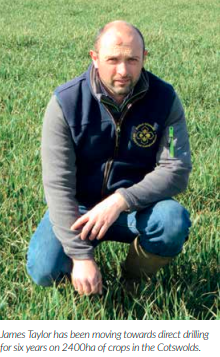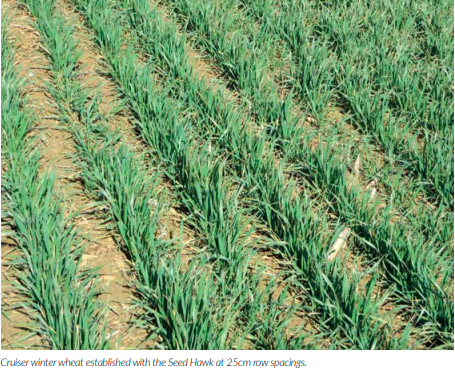WHEN A SEEDHAWK JUST ISN’T ENOUGH

With variable soils and a range of crops on 2400ha at Down Ampney Estate near Cirencester, Glos, Farmcare Ltd’s manager James Taylor relies on versatile drills from Vaderstad which can perform in demanding conditions.
“We’ve got everything from sandy clay loams over gravel to chalk downland and clay with flint,” he explains. “We’ve been moving towards direct drilling over the past six years and have refined the machinery based on our experiences. I reckon that there’s only 20-30% of our land that can be direct drilled every year, and 10% that is not suitable at all, so our drill fleet also has to be versatile enough to work in mintill or conventional seedbeds.” A Vaderstad Rapid A 600 S has proved to fit the bill precisely since its purchase in in 2017.

It is configured with three rows of Vaderstad’s disc coulters rather than the standard levelling board and two rows of coulters, specified to improve soil flow through the drill, and giving the ability to work in mulch and direct seeding applications. “In wet conditions, we have found that soil can gather behind a levelling board and block the coulters. If the land needs levelling, we can use a Dalbo Cultimax ahead of the drill, but generally our Simba SL cultivator does a good job of levelling.” He adds that when direct drilling with a two-row coulter layout previously, soil disturbance was also greater. Mr Taylor compared a number of machines to find a solution to give him the versatility he needs.

“I viewed some Agrovista trial plots where the Rapid was pitted against many of the other direct drills and the results were impressive. It gives us the best of both worlds as it will work in those conditions or go into a conventionally-prepared seedbed.” This drill comes into its own in the spring, Mr Taylor comments: “It gives us plenty of options – it can go in after scratching a seedbed or even work into cover crops,” Mr Taylor comments. He asserts that he is not a ‘direct drilling zealot’. “The conditions have to be right; it’s no good if it compromises crop performance, and we continue to compare the results with the same varieties established conventionally. We will use all the options open to us to achieve results – even ploughing as a ‘reset button’ if all else fails. But if the opportunity presents itself to save money we will do so.”
To pare establishment costs to the minimum where possible, an 8m Seed Hawk direct drill was purchased in 2015. It uses tine openers and coulters at 25cm spacing and has underframe clearance of 30cm to cope with large amounts of trash. “We looked at a wide range of direct drills but discs are not suitable for our stony land and some systems looked to present prohibitive running costs. Other tine drills were seen to smear the slot.”

Mr Taylor’s solution was to develop an approach to get the best out of the Seed Hawk, swapping for the Rapid if necessary. “I assess each field after the combine and if it looks suitable, we’ll just scratch the surface with a set of Carrier discs, allow it to chit and go in with the Seed Hawk.” Where soils need restructuring a 5m Simba SL and 5.5m Unipress create a seedbed in one pass. “The SL has 12 legs to take out compaction and is pulled by 500hp Claas Xerion on wide tyres. We then de-weight the Xerion and put the Seed Hawk on. “This is preferred to using a smaller tractor on 710 tyres, which makes wheel marks that can cause ‘slotting’ of the seeds.” He comments that while the Seed Hawk could run on a smaller tractor, the Xerion pulls it at 1300rpm and uses minimal fuel.
One particular strength of the Seed Hawk, he suggests, is in drilling oilseed rape. “We looked at putting the rape in behind a subsoiler with low disturbance legs, but if there’s compaction to take out, the SL and press does a good enough job for this drill.” There’s plenty of clearance to tackle trashy conditions and the drill’s split tank allows DAP starter fertiliser to be put down the spout at the same time. “The 25cm spacing raises some questions for wheat, although with the demo machine and our own, we have not seen a yield drop from the wider rows.”

Mr Taylor has increased seed rates slightly to take account of wider rows, at 290-300 seeds/sqm, compared to 250-300 seeds/sqm being the norm in September. He is also considering placing Avadex in the drilled rows, which would cut costs from the traditional overall application. He points out that the main impetus for using the Seek Hawk is the cost savings that it can offer in the right conditions. “The labour and fuel savings are impressive – the SL, press and Rapid comes in at £60/ha while the Seed Hawk is £19/ha. If we can put 500ha in with it after harvest that’s a £20,000 saving.” “As part of a farming group, we need efficient systems that provide timely returns rather than waiting for soil conditions to improve, and having equipment that is flexible enough to allow us to consider the soil’s needs is key to that.”